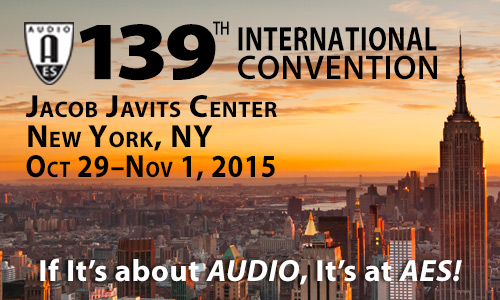
AES New York 2015
Engineering Brief EB2
EB2 - Spatial Audio
Thursday, October 29, 5:30 pm — 6:30 pm (Room 1A08)
Chair:
Bryan Martin, McGill University - Montreal, QC, Canada; Centre for Interdisciplinary Research in Music Media and Technology (CIRMMT) - Montreal, QC, Canada
EB2-1 Array-Based HRTF Pattern Emulation for Auralization of 3D Outdoor Sound Environments with Direction-Based Muffling of Sources—Pieter Thomas, Ghent University - Gent, Belgium; Timothy Van Renterghem, Ghent University - Ghent, Belgium; Dick Botteldooren, Ghent University - Ghent, Belgium
The use of spatial audio reproduction techniques is widely employed for the subjective analysis of concert halls and, more recently, complex outdoor sound environments. In this work a binaural reproduction technique is developed based on a 32-channel spherical microphone array, optimized for the simulation of a virtual microphone with directional characteristics that approximate the directivity of the human head. A set of weights is calculated for each microphone of the constituting array based on a regularized least-square solution. This technique allows for adaptation of the auditory scene based on source direction. The performance of variants of the technique has been evaluated by means of listening tests. Furthermore, its use for the auralization of outdoor soundscapes has been illustrated.
Engineering Brief 205 (Download now)
EB2-2 Polar Pattern Comparisons for the Left, Center, and Right Channels in a 3-D Microphone Array—Margaret Luthar, Sonovo Mastering - Stavanger, Norway; Elaine Maltezos, University of Stavanger - Bergen, Norway
Standard 5.1 microphone arrays are long established and have been applied to psychoacoustic research, as well as for commercial purposes in film and music. Recent interest in the creative possibilities of “3-D audio” (a lateral layer of microphones, as well as an additional height layer) has led to research in both adapting 5.1 arrays for 3-D recordings as well as creating new methods to better capture the listener’s experience. The LCR configuration in a 5.1 array is a factor that contributes to the stability and localization of the auditory image in the horizontal plane. In this experiment, two different LCR configurations have been adapted for 9.1 in a traditional concert-recording environment. They are then compared in various combinations for their ability to produce a stable, natural, and effective frontal image in a 9.1 reproduction method. Preliminary listening suggests that the polar characteristics of the L,C, and R microphones do affect the sense of envelopment, spaciousness, and localization of the frontal image, as well as cohesiveness within the entire 9.1 image. These results have led to options for further study, as suggested by the researchers.
Engineering Brief 206 (Download now)
EB2-3 Coding Backward Compatible Audio Objects with Predictable Quality in a Very Spatial Way—Stanislaw Gorlow, Gorlow Brainworks - Paris, France
A gradual transition from channel-based to object-based audio can currently be observed throughout the film and the broadcast industries. One paramount example of this trend is the new MPEG-H 3D Audio standard, which is under development. Other object-based standards in the market place are DTS:X and Dolby Atmos. In this engineering brief a newly developed prototype of an object-based audio coding system is introduced and discussed in terms of its technical characteristics. The codec can be of use everywhere where a given sound scene is to be rerendered according to the listener’s preference or environment in a backward compatible manner. The areas of application cover not only interactive music listening or remixing, but also location-dependent, immersive, and 3D audio rendering.
Engineering Brief 207 (Download now)
EB2-4 Decorrelated Audio Imaging in Radial Virtual Reality Environments—Bryan Dalle Molle, University of Illinois at Chicago - Chicago, IL, USA; James Pinkl, University of Illinois at Chicago - Chicago, IL, USA; Mark Blewett, University of Illinois at Chicago - Chicago, IL, USA
University of Illinois at Chicago's CAVE2 is a large-scale, 320-degree radial visualization environment with a 360-degree 20.2 channel radial speaker system. The purpose of our research is to develop solutions for spatially accurate playback of audio within a virtual reality environment, reconciling differences between the circular speaker array, the location of a user in the physical space, and the location of virtual sound objects within CAVE2’s OmegaLib virtual reality software, all in real time. Previous research presented at AES 137 detailed our work on object geometry, dynamically mapping a virtual object’s width and distance to the speaker array with volume and delay compensation. Our recent work improves virtual width perception using dynamic decorrelation with transient fidelity, implemented via Supercollider on the CAVE2 sound server.
Engineering Brief 208 (Download now)
